On board the ISS created ultracold substance
- Transfer
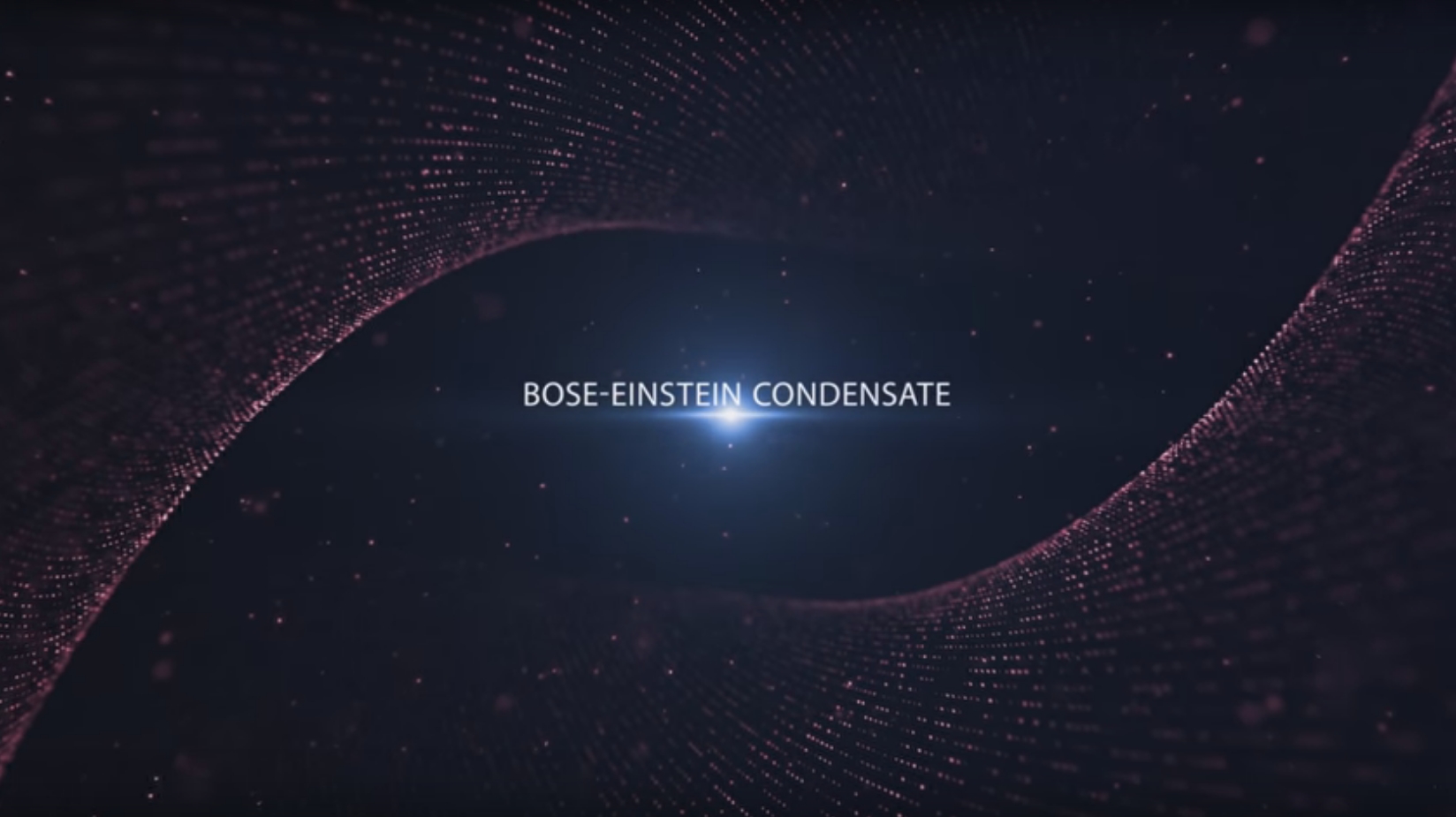
Source of the frame: Youtube
Know: the most amazing of space experiments begin on the ISS.
Hidden text
(прим.перев.: coolest, то есть «максимально холодный» и одновременно «самый крутой, потрясный», игра слов).
The installation of cold NASA atoms (Cold Atom Laboratory, CAL), installed aboard the station in May, produced a suspension of ultracold atoms, also known as Bose-Einstein condensate (Bose-Einstein condensates, BEC). WEB is at a temperature a fraction of a degree above absolute zero, a point at which — theoretically — in any substance the thermal motion of particles stops. Previously, such experiments were carried out only on Earth.
Onboard the ISS, the installation of cold atoms NASA will generate ultracold atoms to conduct experiments in quantum physics under microgravity conditions. Atoms are cooled to one ten billionth of a degree above absolute zero (on average it is ten billion times colder than in deep space). Physicists believe that observing the unusual behavior of particles at such low temperatures will provide answers to questions about the fundamental structure of matter.
CAL is a multi-user facility designed to study the basic foundations of the surrounding world using ultracold atoms under microgravity conditions. “Cold” atoms are long-lived (by quantum standards) particles that can be controlled with high accuracy; thus, they are ideal for considering quantum phenomena and the potential application of quantum technologies.
In orbit such a device is placed for the first time; it is expected that it will become a powerful tool for ultra-precise measurements of the gravitational field, research on the long-standing problems of quantum physics and comprehension of the wave nature of matter.
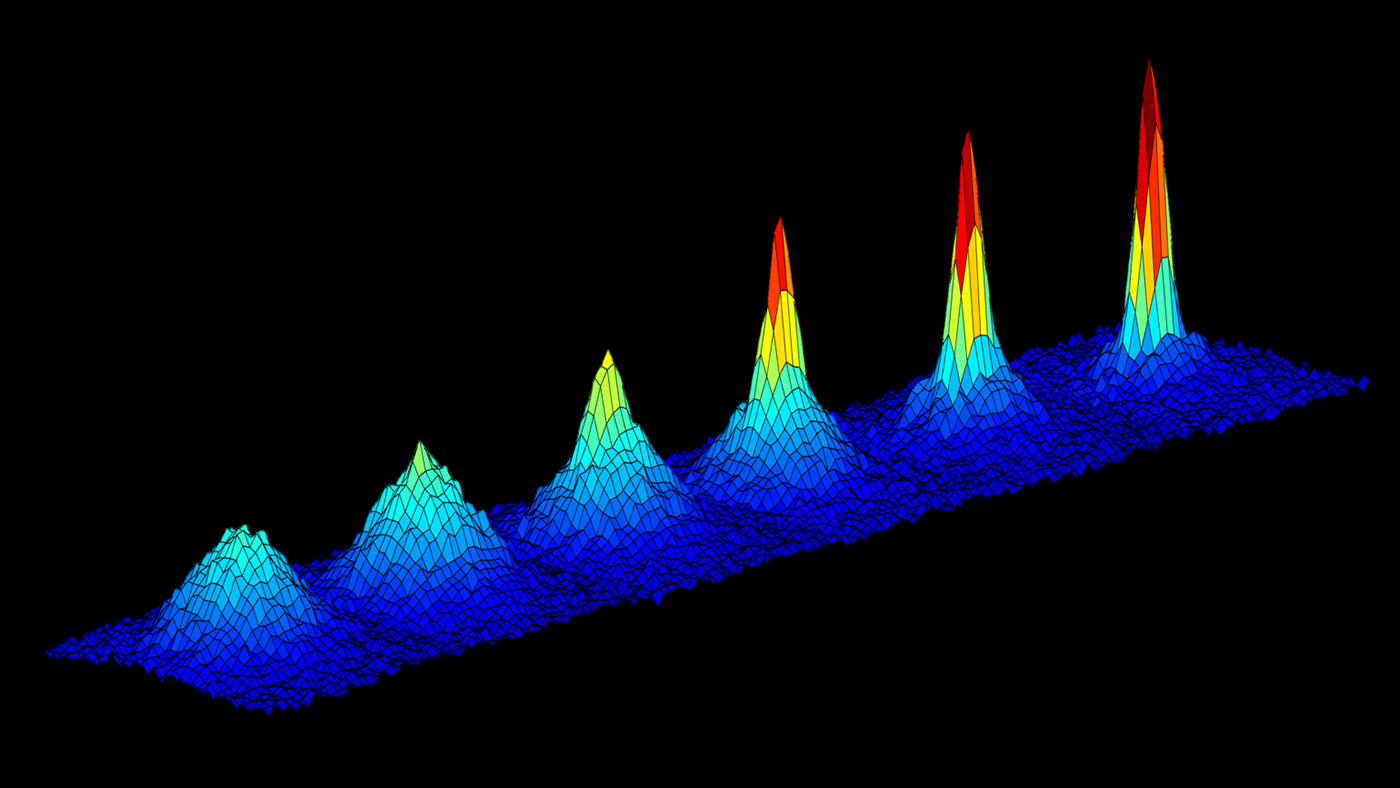
A series of graphs demonstrates a change in the density of the atomic suspension with a decrease in temperature (from left to right) until it approaches absolute zero. The emergence of a sharp peak in the final stages is evidence of the formation of Bose-Einstein condensate - the fifth state of matter - which appears at temperatures of about 130 nano Kelvin. Source: NASA / JPL-Caltech
“The opportunity to experiment with BEC aboard the ISS is a dream that has finally come true,” says Robert Thompson, lead specialist of the CAL project and physicist of the NASA Jet Propulsion Laboratory (JPL) in Pasadena, California “For the sake of this moment, we have traveled a long and difficult path, but all our efforts will pay off a hundredfold, since this installation opens up the widest field for us to experience.”
Last week, scientists working with CAL confirmed the formation of condensate from rubidium atoms, with a temperature of about 100 nano Kelvin; it's colder than the average temperature in space (about three kelvins, or -270 degrees Celsius). However, this is not the limit - it is further expected to get even lower temperatures, even in comparison with those reached in terrestrial laboratories.
At such temperatures, the atoms begin to behave differently than in any other known and observed by us substance. BEC is called the “fifth state of matter,” thereby separating it from solid, liquid, gaseous, and plasma; since condensate atoms behave more like waves than particles. The wave nature of matter can only be observed in ultra-small scale phenomena, but BEC makes them more noticeable - and therefore it is easier to analyze them. Ultracold atoms are in a state with minimal energy and take the same wave state, becoming indistinguishable from each other; the atomic cloud begins to behave entirely as a kind of single "superat".
Difficult thing
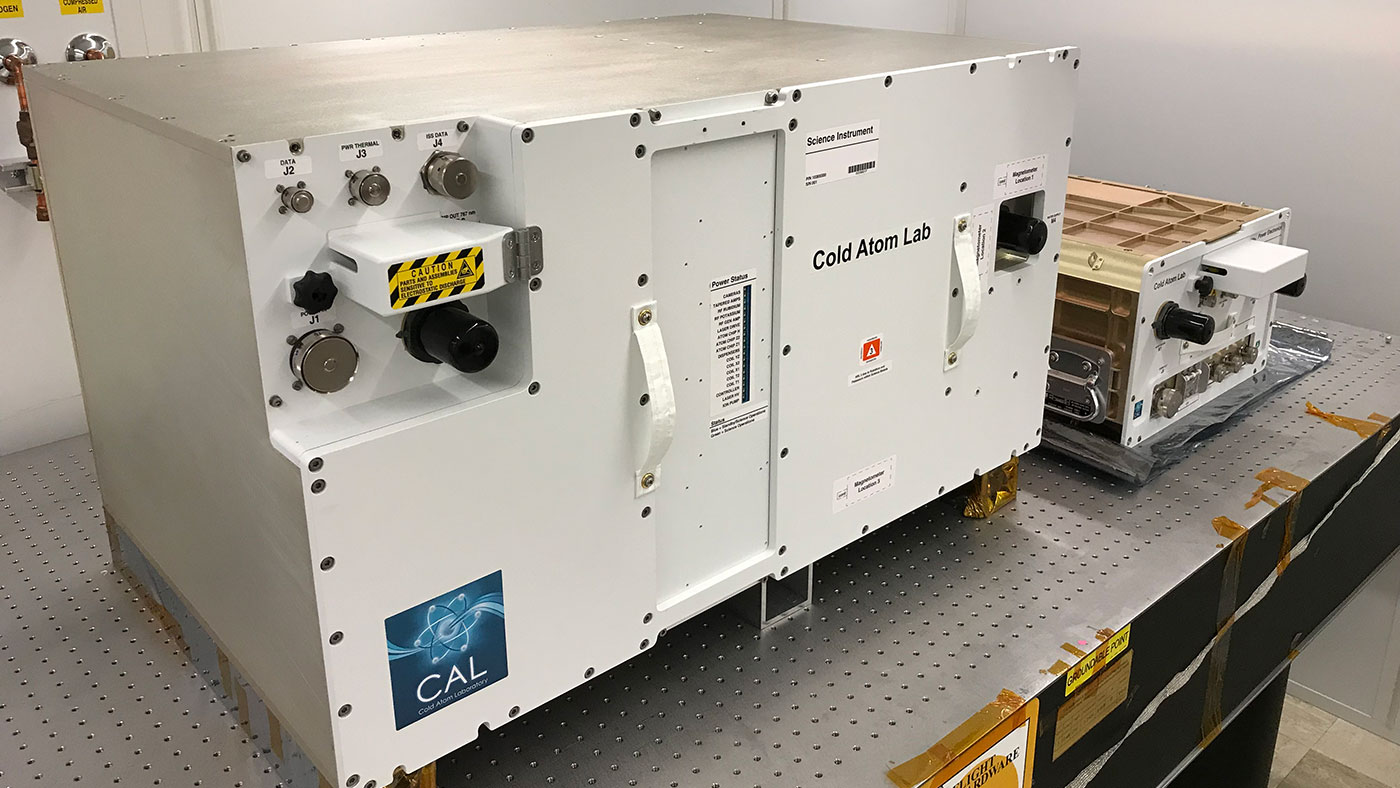
CAL consists of two standardized units that will be installed onboard the ISS. The big block is jokingly called the "four-chamber refrigerator", and the small one - the "single-chamber"; big and contains all the stuffing that produces ultracold atoms. Source: NASA / JPL-Caltech / Tyler Winn
“This is a damn complicated tool,” explains Robert Shotwell, JPL Chief Physics and Astronomy Engineer, who oversaw all work on the installation since February 2017. “Usually such tricks require a pile of equipment with room size, and even constant direct supervision is needed, and we have created a device no larger than a portable refrigerator and can manage it from the Earth. We had to break down a lot of barriers and make a lot of effort to ensure that this puzzling thing ended up on the space station today. ”
The first Bose-Einstein condensate was obtained in 1995, although the phenomenon itself was predicted by physicists Shatiendranath Bose and Albert Einstein 71 years before. In 2001, Eric Cornell, Karl Wiemann and Wolfgang Ketterle shared the Nobel Prize in Physics for creating and studying the characteristics of WEC in the laboratory; In the following year, five research groups, including those led by Cornell and Ketterle, will conduct experiments with cold atoms. Since the mid-nineties, scientists around the world have made hundreds of such experiments; most of them are on Earth, but a few in short space flights - aboard geophysical rockets. Finally, science received a way to carry out everyday experiments with condensate for a long period of time aboard the ISS.
BEC is produced in non-material “atomic traps” created by magnetic fields or lasers. In the earth's field when the trap is turned off, ultracold atoms disperse almost immediately with attraction, so they can be observed only for a fraction of a second. However, in microgravity conditions, a suspension exists from five to ten seconds; the total for the day, scientists recruited up to six hours of observations.
As soon as the pressure drops inside the trap, the temperature naturally decreases; the longer the cloud of atoms remains in the trap, the colder it becomes. Those who worked with a can of paint, this phenomenon is familiar - the can is cooled just because of the pressure drop. In microgravity, the condensate pressure drops to ultra small values, reducing in turn the temperature to values unattainable by earthly tools. Day after day, the installation works without any intervention from the station crew.
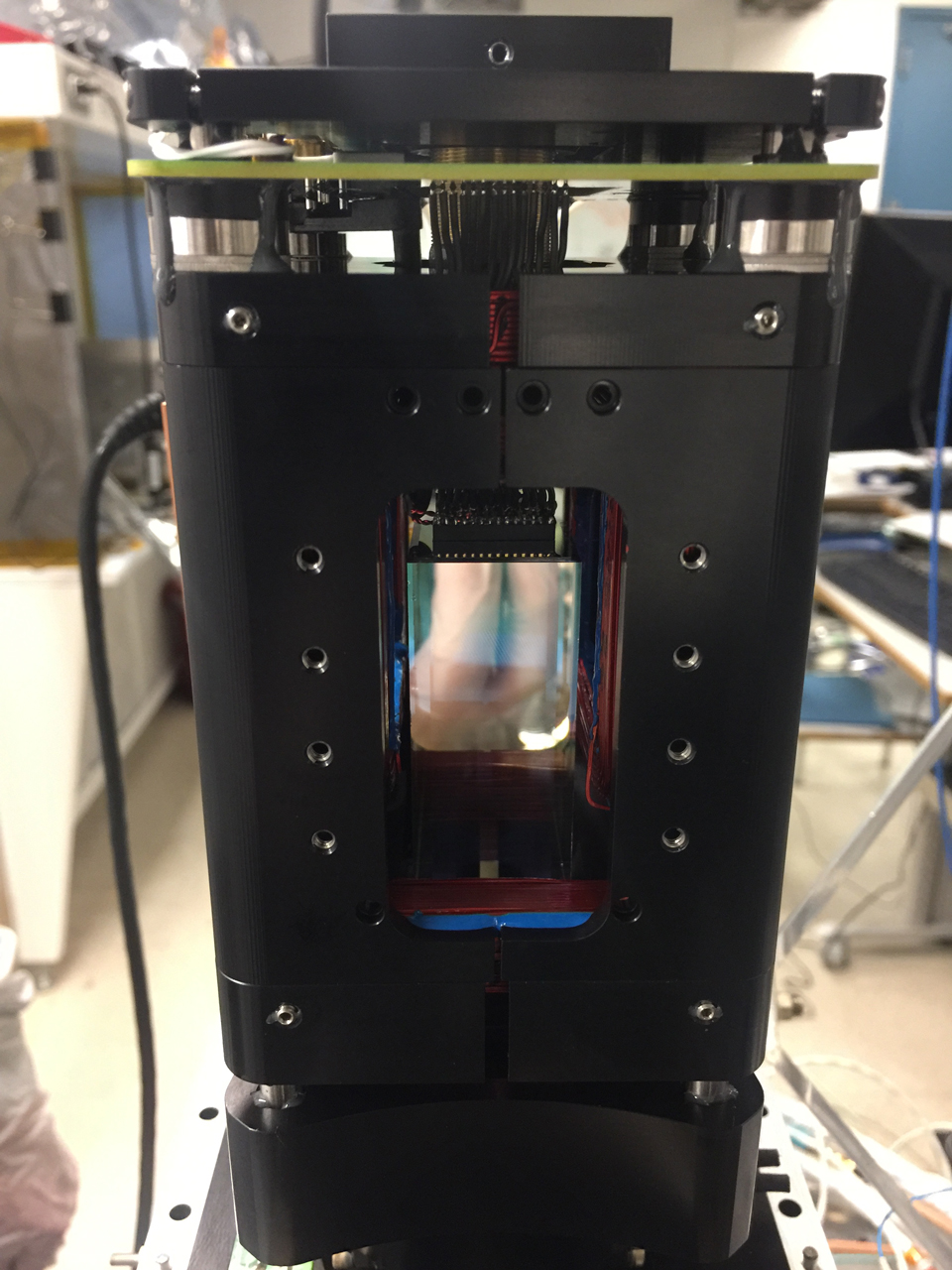
It is here that the Bose-Einstein condensate originates inside the CAL. Source: NASA / JPL-Caltech / Tyler Winn
After obtaining BEC from rubidium, the research team is going to use the atoms of two different potassium isotopes. In fact, commissioning work is now being carried out at CAL, so a long series of tests are needed to determine how well the device works well in microgravity conditions.
“Scientists from all over the world will not wait for permission to work on our facility,” says Kamal Odrihri, head of the CAL mission at JPL. “And since a huge amount of various experiments are planned, we will have to adapt to microgravity a lot of ways to cool atoms and manipulate them, than we will give this device into the hands of narrow specialists for serious work. ” The stage of scientific research on the schedule starts in early September of this year and will last at least three years.
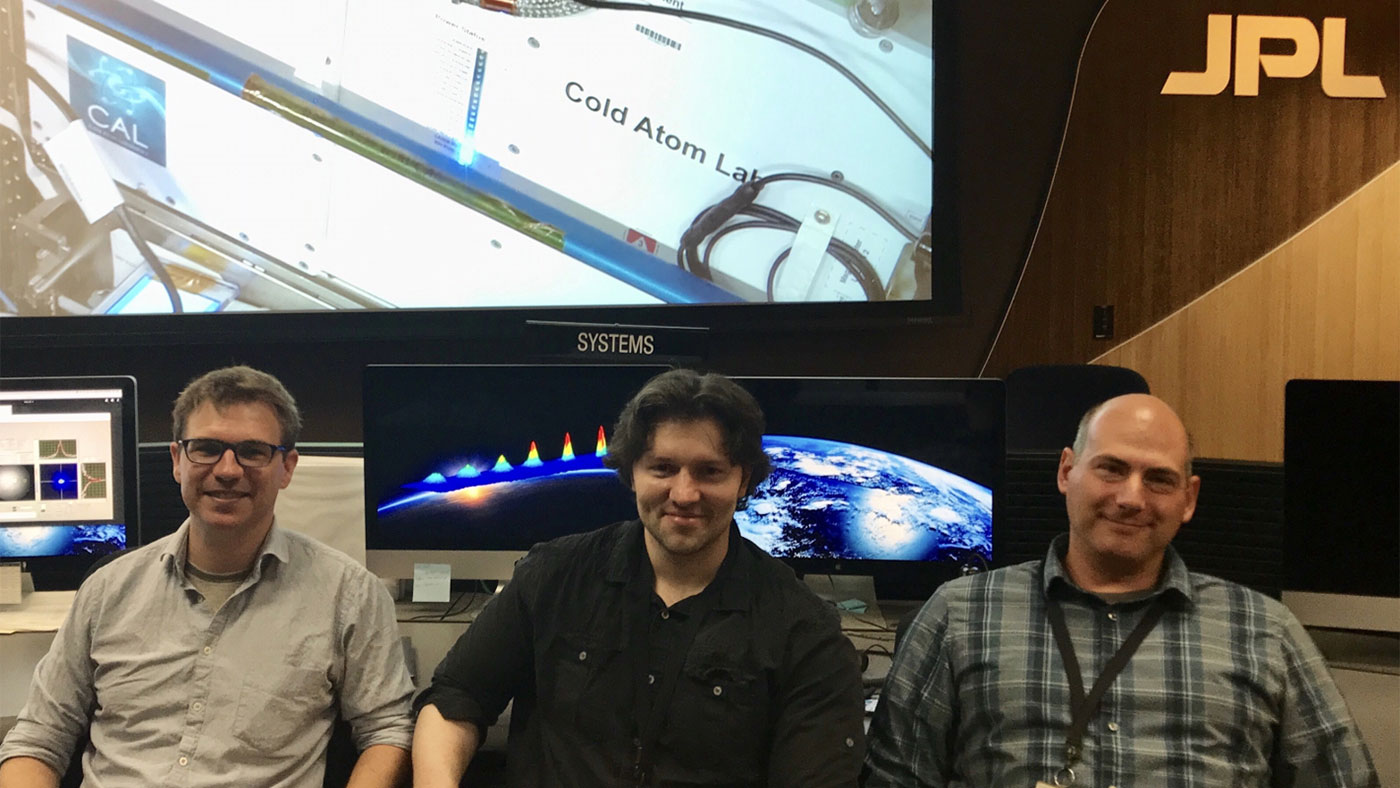
CAL atomic physics specialists and JPL scientists David Avelyn, Ethan Elliott and Jason Williams (from left to right); The photo was taken at the Earth Orbiting Missions Operation Center in JPL, from where CAL will be remotely controlled and configured. The image on the screen in the background shows the installation directly onboard the ISS. The work of Avelin, Elliott and Williams played a decisive role in getting the Bose-Einstein in the orbit of the world's first condensate. Source: NASA / JPL-Caltech
Installation of cold atoms went into space on May 21, 2018 on the Cygnus orbital spacecraft from the Wallops space centerVirginia. CAL was developed and built at JPL, and funding for the project is shared between the International Space Station Program at the Lyndon Johnson Space Center, Houston, and the Space Life and Physical Sciences Research and Applications Division (SLPSRA) of the Space Development Directorate and operational management of NASA missions, at NASA headquarters, Washington.
For more information, you can visit the project website .
